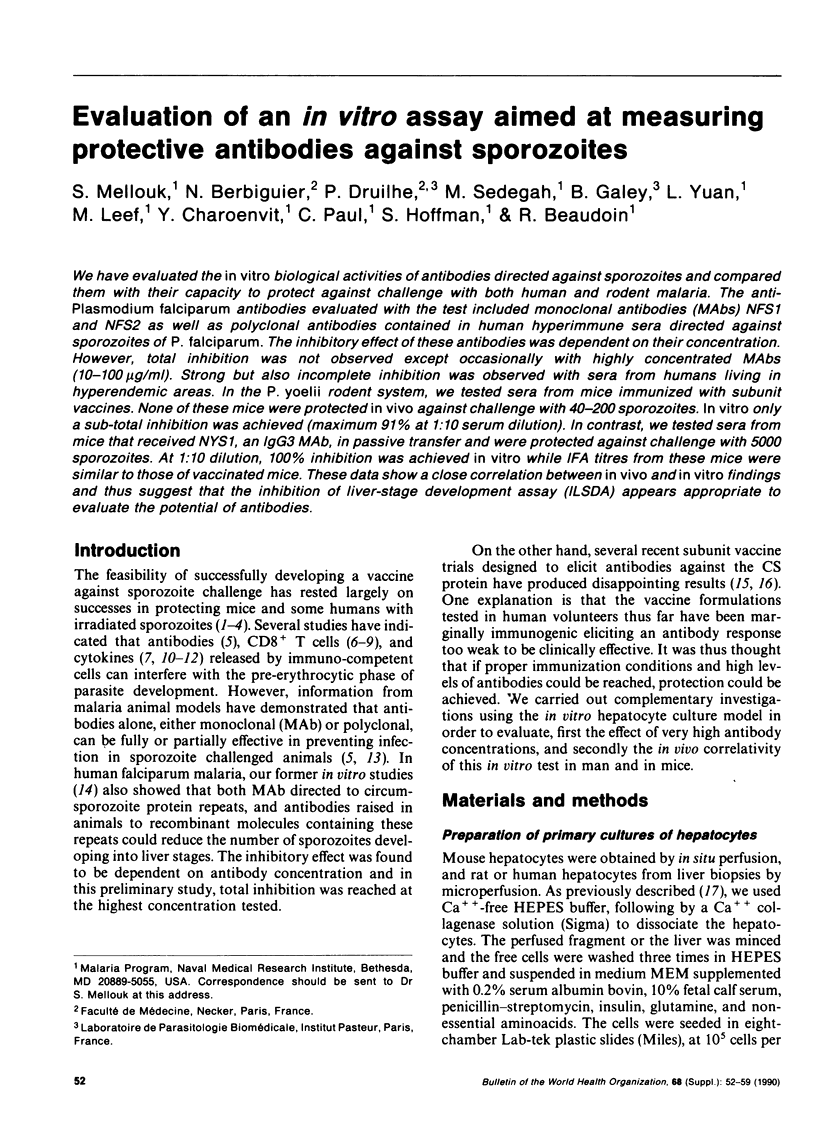Abstract
We have evaluated the in vitro biological activities of antibodies directed against sporozoites and compared them with their capacity to protect against challenge with both human and rodent malaria. The anti-Plasmodium falciparum antibodies evaluated with the test included monoclonal antibodies (MAbs) NFS1 and NFS2 as well as polyclonal antibodies contained in human hyperimmune sera directed against sporozoites of P. falciparum. The inhibitory effect of these antibodies was dependent on their concentration. However, total inhibition was not observed except occasionally with highly concentrated MAbs (10-100 micrograms/ml). Strong but also incomplete inhibition was observed with sera from humans living in hyperendemic areas. In the P. yoelii rodent system, we tested sera from mice immunized with subunit vaccines. None of these mice were protected in vivo against challenge with 40-200 sporozoites. In vitro only a sub-total inhibition was achieved (maximum 91% at 1:10 serum dilution). In contrast, we tested sera from mice that received NYS1, an IgG3 MAb, in passive transfer and were protected against challenge with 5000 sporozoites. At 1:10 dilution, 100% inhibition was achieved in vitro while IFA titres from these mice were similar to those of vaccinated mice. These data show a close correlation between in vivo and in vitro findings and thus suggest that the inhibition of liver-stage development assay (ILSDA) appears appropriate to evaluate the potential of antibodies.
Full text
PDF







Selected References
These references are in PubMed. This may not be the complete list of references from this article.
- Ballou W. R., Hoffman S. L., Sherwood J. A., Hollingdale M. R., Neva F. A., Hockmeyer W. T., Gordon D. M., Schneider I., Wirtz R. A., Young J. F. Safety and efficacy of a recombinant DNA Plasmodium falciparum sporozoite vaccine. Lancet. 1987 Jun 6;1(8545):1277–1281. doi: 10.1016/s0140-6736(87)90540-x. [DOI] [PubMed] [Google Scholar]
- Bruce-Chwatt L. J. Recent trends of chemotherapy and vaccination against malaria: new lamps for old. Br Med J (Clin Res Ed) 1985 Oct 19;291(6502):1072–1076. doi: 10.1136/bmj.291.6502.1072. [DOI] [PMC free article] [PubMed] [Google Scholar]
- Charoenvit Y., Sedegah M., Yuan L. F., Gross M., Cole C., Bechara R., Leef M. F., Robey F. A., Lowell G. H., Beaudoin R. L. Active and passive immunization against Plasmodium yoelii sporozoites. Bull World Health Organ. 1990;68 (Suppl):26–32. [PMC free article] [PubMed] [Google Scholar]
- Clyde D. F. Immunization of man against falciparum and vivax malaria by use of attenuated sporozoites. Am J Trop Med Hyg. 1975 May;24(3):397–401. doi: 10.4269/ajtmh.1975.24.397. [DOI] [PubMed] [Google Scholar]
- Druilhe P., Pradier O., Marc J. P., Miltgen F., Mazier D., Parent G. Levels of antibodies to Plasmodium falciparum sporozoite surface antigens reflect malaria transmission rates and are persistent in the absence of reinfection. Infect Immun. 1986 Aug;53(2):393–397. doi: 10.1128/iai.53.2.393-397.1986. [DOI] [PMC free article] [PubMed] [Google Scholar]
- Herrington D. A., Clyde D. F., Losonsky G., Cortesia M., Murphy J. R., Davis J., Baqar S., Felix A. M., Heimer E. P., Gillessen D. Safety and immunogenicity in man of a synthetic peptide malaria vaccine against Plasmodium falciparum sporozoites. Nature. 1987 Jul 16;328(6127):257–259. doi: 10.1038/328257a0. [DOI] [PubMed] [Google Scholar]
- Hoffman S. L., Isenbarger D., Long G. W., Sedegah M., Szarfman A., Waters L., Hollingdale M. R., van der Meide P. H., Finbloom D. S., Ballou W. R. Sporozoite vaccine induces genetically restricted T cell elimination of malaria from hepatocytes. Science. 1989 Jun 2;244(4908):1078–1081. doi: 10.1126/science.2524877. [DOI] [PubMed] [Google Scholar]
- Hoffman S. L., Oster C. N., Mason C., Beier J. C., Sherwood J. A., Ballou W. R., Mugambi M., Chulay J. D. Human lymphocyte proliferative response to a sporozoite T cell epitope correlates with resistance to falciparum malaria. J Immunol. 1989 Feb 15;142(4):1299–1303. [PubMed] [Google Scholar]
- Hoffman S. L., Oster C. N., Plowe C. V., Woollett G. R., Beier J. C., Chulay J. D., Wirtz R. A., Hollingdale M. R., Mugambi M. Naturally acquired antibodies to sporozoites do not prevent malaria: vaccine development implications. Science. 1987 Aug 7;237(4815):639–642. doi: 10.1126/science.3299709. [DOI] [PubMed] [Google Scholar]
- Hope I. A., Hall R., Simmons D. L., Hyde J. E., Scaife J. G. Evidence for immunological cross-reaction between sporozoites and blood stages of a human malaria parasite. Nature. 1984 Mar 8;308(5955):191–194. doi: 10.1038/308191a0. [DOI] [PubMed] [Google Scholar]
- Mellouk S., Maheshwari R. K., Rhodes-Feuillette A., Beaudoin R. L., Berbiguier N., Matile H., Miltgen F., Landau I., Pied S., Chigot J. P. Inhibitory activity of interferons and interleukin 1 on the development of Plasmodium falciparum in human hepatocyte cultures. J Immunol. 1987 Dec 15;139(12):4192–4195. [PubMed] [Google Scholar]
- Potocnjak P., Yoshida N., Nussenzweig R. S., Nussenzweig V. Monovalent fragments (Fab) of monoclonal antibodies to a sporozoite surface antigen (Pb44) protect mice against malarial infection. J Exp Med. 1980 Jun 1;151(6):1504–1513. doi: 10.1084/jem.151.6.1504. [DOI] [PMC free article] [PubMed] [Google Scholar]
- Romero P., Maryanski J. L., Corradin G., Nussenzweig R. S., Nussenzweig V., Zavala F. Cloned cytotoxic T cells recognize an epitope in the circumsporozoite protein and protect against malaria. Nature. 1989 Sep 28;341(6240):323–326. doi: 10.1038/341323a0. [DOI] [PubMed] [Google Scholar]
- Schofield L., Villaquiran J., Ferreira A., Schellekens H., Nussenzweig R., Nussenzweig V. Gamma interferon, CD8+ T cells and antibodies required for immunity to malaria sporozoites. Nature. 1987 Dec 17;330(6149):664–666. doi: 10.1038/330664a0. [DOI] [PubMed] [Google Scholar]
- Spitalny G. L., Rivera-Ortiz C. I., Nussenzweig R. S. Plasmodium berghei: the spleen in sporozoite-induced immunity to mouse malaria. Exp Parasitol. 1976 Oct;40(2):179–188. doi: 10.1016/0014-4894(76)90080-1. [DOI] [PubMed] [Google Scholar]
- Weiss W. R., Mellouk S., Houghten R. A., Sedegah M., Kumar S., Good M. F., Berzofsky J. A., Miller L. H., Hoffman S. L. Cytotoxic T cells recognize a peptide from the circumsporozoite protein on malaria-infected hepatocytes. J Exp Med. 1990 Mar 1;171(3):763–773. doi: 10.1084/jem.171.3.763. [DOI] [PMC free article] [PubMed] [Google Scholar]
- Weiss W. R., Sedegah M., Beaudoin R. L., Miller L. H., Good M. F. CD8+ T cells (cytotoxic/suppressors) are required for protection in mice immunized with malaria sporozoites. Proc Natl Acad Sci U S A. 1988 Jan;85(2):573–576. doi: 10.1073/pnas.85.2.573. [DOI] [PMC free article] [PubMed] [Google Scholar]


